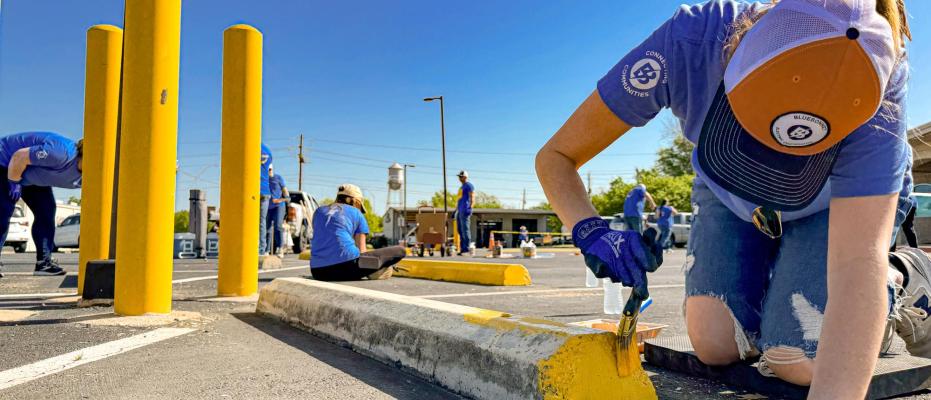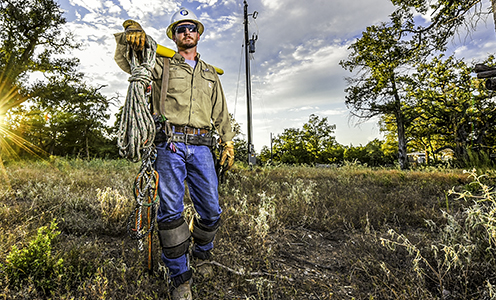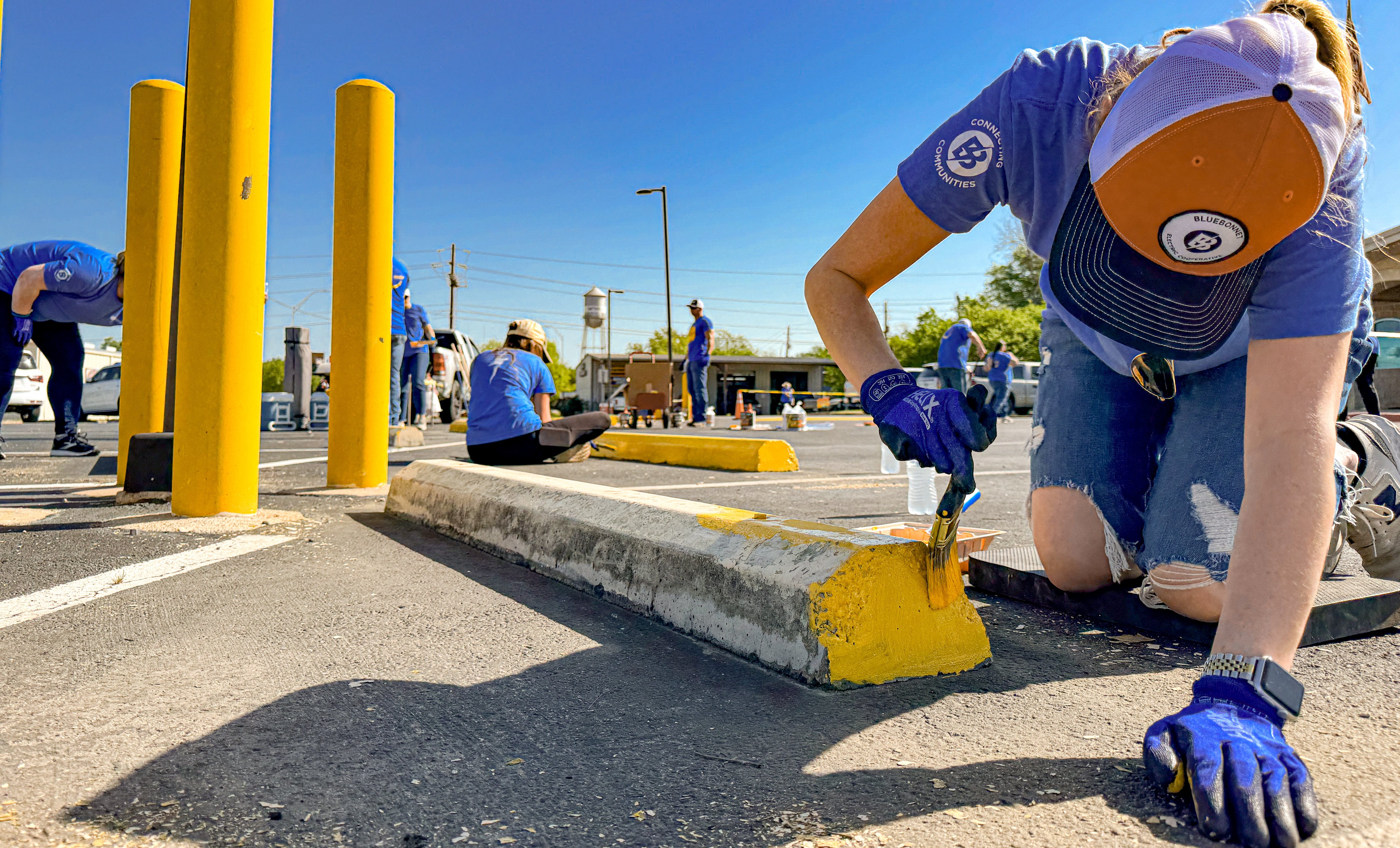We’re your neighbors
Giving back to communities we serve.

Community news
By Denise Gamino
Nearly 90 years ago, a widowed mother chose to starve to death in a Fayette County jail cell rather than die in the electric chair for the killing of a farmhand. She lost 150 fatal pounds. Before she died, Mary Dach wished aloud to someday be free, and to get a job in the jail that confined her. Perhaps she did.
Can anyone say, beyond a reasonable doubt, whether Dach’s spirit lingered and led to the many mysterious occurrences reported in the old 1883 Victorian Gothic stone jail in downtown La Grange? Eerie episodes over the decades include sightings of orbs and apparitions, doors slamming, lights swinging, objects moving and even the sounds of heavy chains toppling.
“There are unsettled spirits” in the old jail, said Cathy Chaloupka, who officed in the renovated jail as director of tourism for the La Grange Chamber of Commerce for nine years, until 2005. “They got used to me, and I got used to them.”
Could the phantom presence of Mary Dach, a towering woman with braided black hair wound around her head, have turned on darkened lights, opened drawers meant to be closed and creaked loudly on the wooden staircase? Some say yes; others say no way.
But few can argue that the saga of Mary Dach — which made international headlines at the time, but is little known or talked of today — has not lost its shock factor.
If someone’s afterlife spirit really could be unsettled, hers would be a contender.
Mary Dach, a woman of German heritage who spoke little English, confessed to fatally shooting the farm helper she hired after her husband died of cancer in 1929 or 1930, leaving her alone with three young children on a 168-acre farm 17 miles south of La Grange. According to period accounts, Dach claimed farmhand Henry Stoever had been abusive to her and the children, two girls and a boy, ages 8, 6 and 4 at the time.
Dach’s oldest daughter, who is now deceased, finally broke the family’s public silence about the case with the Fayette County Record when she was 89. The farmhand who was murdered was mean and abusive, regularly assaulting her mother and little brother, she said. She did not witness his murder but remembered circumstantial evidence that someone other than her mother killed Stoever. The grown daughter, Annie Polnick, remembered hearing someone tell her mother that she and her three children would be killed if the truth came out.
“Mama was real dumb as she could have told the truth and got her life safe,” Polnick said in a 10-page, handwritten memoir dated 2001 — the year she told her own three children about their grandmother for the first time. By then, her oldest child was 55. “So to me as I understand it, she died for us kids.”
The official version of the Mary Dach crime story began in mid-April 1933, when Fayette County law officers began searching for Stoever after his brother reported him missing. Dach gave conflicting accounts about Stoever’s whereabouts each time law officers visited her farm during their first week of inquiry. On the seventh day, investigators found Stoever’s body. It was burned and buried in an 8-by-16-foot hole filled with debris and dirt and topped by a new chicken coop, just 18 feet from Dach’s farmhouse.
After being taken into custody and interrogated in German and English by four investigators for four hours, Dach admitted to shooting Stoever in the head with a shotgun as he slept to protect her family, according to press accounts.
The Austin Statesman, the capital city’s afternoon newspaper at the time, reported that the “Widow Dach” admitted shooting her laborer “because he was cruel to her children and herself, threatened their lives and swore he would throw their bodies into a hole he had dug near the house for a flower pit.”
Instead, the paper noted, “it was his body which finally rested in that grave he had dug with his own hands,” perhaps as a planned cellar.
The sad case only turned more tragic when Dach refused to eat after her arrest. “I’ll not eat until I know what they are going to do with me,” she told jailers, according to a June 1935 Famous Detective Cases magazine article that recounts the case in an as-told-by format with then-Fayette County Chief Deputy Sheriff Jim Flournoy. (He later became sheriff and reluctantly shut down the infamous “Chicken House” brothel after an exposé by a Houston reporter.)
Dach lost 50 pounds in the five weeks between her arrest on April 18, 1933, and opening day of her four-day trial in La Grange on May 22. She had sipped little more than a bit of soup and some coffee. “She held out for thirteen days, then began to eat slowly. She cried constantly and asked to see her children,” stated an Associated Press story in The Dallas Morning News.
It took two days of questioning two jury pools — 125 men — to find 12 qualified jurors. Women were not allowed to sit on a jury in Texas until 1954. “Many of the talesmen [potential jurors] disqualified themselves because they said they were opposed to infliction of the death penalty on a woman,” the AP reported.
“The court room is crowded and the heat is fierce but the spectators, men and women are not to be robbed of their curiosity and interest,” stated a May 25, 1933, article in the weekly La Grange Journal. Dach required an interpreter to translate the English dialogue. “She remains mute as she sits beside her attorney and regards the proceedings.”
When the verdict came at 9 p.m. on May 25, Dach couldn’t understand much besides the word “death.”
She was found guilty and sentenced to be executed. She would have been the first woman in Texas to be put to death in the electric chair at the state penitentiary in Huntsville.
“She received the verdict without a word,” according to the La Grange Journal. “Her face blanched when the word ‘death’ was pronounced, but she made no effort to speak. She was entirely alone in the courtroom, no relatives were there to comfort her. She was lead (sic) slowly away to her cell, where she gave way to a burst of weeping, but still refused to say anything about the sentence.”
Even though her attorney immediately filed a motion for a new trial, Dach told a jailer, in German, “I will not eat.” according to a media report. “It is no use to live any longer,” she reportedly said. “It is about all over with me, I fear.”
She sought comfort from a German bible. And she reportedly hung the chair in her jail cell from the ceiling to place the “the electric chair out of reach,” the La Grange Journal reported.
News accounts of the day often gave varying ages and first names for Dach. Public records and christening documents show her name inconsistently as Maria, Marrie, Marie and Mary. Conflicting reports varied her age from 34 to 43. Her 1933 death certificate states she was 43.
Officials did not try to force feed Dach. Days before her death on Aug. 23, 1933, “she was unconscious on the cot in her jail cell. A physician watched her closely and then began to treat her for a stomach ailment,” according to an AP story. Dach's three children were reported to be present at the time of their mother's death.
On her death certificate, the cause of death was “voluntary starvation.”
She weighed 100 pounds.
Dach’s children were raised by their maternal grandmother. The family — and the community — was tightlipped about the entire ghastly episode. Even today, not everyone in Fayette County feels comfortable talking about the 1933 event.
In her memoir, Dach’s oldest daughter, Polnick, wrote about then-Fayette County Sheriff Will Loessin and deputy Flournoy accompanying the young Dach children to school after their mother’s death: “They both talked to all the kids in school and then they took us in and introduced us to the children and (there was) not a one time that one of the children would mention anything about us.”
That silent community pact kept Mary Dach’s grandchildren from knowing what had happened.
“It was mind-boggling to the entire family” when Polnick revealed the story to her own children in 2001, said her oldest son, Sonny Polnick of Houston, the oldest grandchild of Mary Dach. She decided to open up after a writer sought her out, he said.
Suddenly, he said, it made sense “why people looked at me kind of weird” during childhood when he was introduced as Annie Polnick’s son.
Annie Polnick raised her family in Houston, where she worked for the National Biscuit Co. and volunteered for 13 years at the Harris County Sheriff’s Office to help children in need. It is not known whether Annie Polnick knew that her mother had a similar aspiration to work with law enforcement.
Mary Dach had told the Austin Statesman after her conviction: “I tell myself sometimes, if I get out of my trouble maybe I could get a job at the jail doing some kind of work.”
Sonny Polnick has visited the old jail in La Grange, where just a remnant of a jail cell remains. He said “it was eerie” to see the cell and couldn’t imagine his grandmother “being cooped up in there and starving herself to death.” He wonders whether his grandmother would be convicted if her trial were held in today’s criminal justice system — with modern forensics, a diverse jury, accommodations for language barriers and the rights afforded today’s criminal suspects.
Although Sonny Polnick never felt his grandmother’s presence in the old jail, others say they have. “I did see her image one Saturday morning,” Chaloupka said. “It was just a fleeting kind of thing for me.” But one of Chaloupka’s colleagues worked in the area where the women’s jail cell had been, on the second floor, and saw a figure watching him one day. “It made the hair stand up on the back of my neck,” that worker told the Houston Chronicle in 2002.
When unsettling things happened to Chaloupka — such as the sound of heavy chains dropping to the ground behind her chair or a light bulb flying out of its socket toward her — she tried to tell the spirits that she needed to work. After the light bulb incident, “I would sing ‘Amazing Grace’ in the mornings, and it never happened again,” she said. “They got used to me, and I got used to them.”
However, “sometimes the toilet lid would fly up with a loud bang. I think that was Sheriff Jim’s joke,” she said, referring to Flournoy.
The old jail now houses the Texas Heroes Museum, which honors Texas veterans. At least one otherworldly episode has occurred since the museum opened in 2016. A no-nonsense, all business volunteer was surprised to see a second-floor security camera pick up the image of a large white orb floating in the air. “It was about the size of a basketball,” the volunteer said. “I watched it for about 10 minutes.”
Paranormal activity by definition cannot be explained.
Today, the museum simply displays a visitor information sheet about deaths in the old jail. It concludes: “You’ll need to come visit and decide for yourself if there are any unhappy souls still not at peace in the old jail.
Download this story as it appeared in the Texas Co-op Power magazine »
When Hurricane Laura made landfall in the early hours of Aug. 27, 2020, its devastating winds, rain and storm surge left hundreds of thousands of people without power across Louisiana and East Texas. Central Texans dodged damage from this storm, which enabled Bluebonnet Electric Cooperative to help out hard-hit utilities.
Two Bluebonnet crews with 10 line workers, equipped with bucket and digger trucks, tracked machines and all-terrain vehicles, replaced poles and repaired power lines across rain-soaked, swampy areas and lakes. They were among more than 200 line workers and support personnel helping restore power to members of Deep East Texas Cooperative near the Louisiana border. More than half of that cooperative’s 40,000 meters across eight counties lost power.
“The work has been hot and humid. We’ve been picking up wire under massive pine trees,” said crew supervisor Chris Rivera from the field. “But the experience has been good. We worked two days to get the town of Burkeville back on, and once we did, it was a very rewarding feeling. The members were very appreciative.”
Bluebonnet also released 26 contractor crews — 12 four-person construction crews and 14 three-person tree trimming crews — to help utilities in the two states.
Download this story as it appeared in the Texas Co-op Power magazine »
Story by Ed Crowell
When Melanie Pavlas can get away from paperwork at her small upstairs office on Main Street in Bastrop, she heads for the green part of her job amid rolling hills, prairies and riverfront trails.
As executive director of Pines and Prairies Land Trust, Pavlas is responsible for ownership and management of three nature preserves totaling more than 1,000 acres. At least once a year she visits seven privately owned farms and ranches in the Bluebonnet region to consult with landowners about how they’re protecting their land under conservation easements held by the trust.
Founded as a nonprofit in 2001, Pines and Prairies operates in all of Bastrop, Caldwell, Fayette and Lee counties and in eastern Travis County.
Thirty-three other land trusts in Texas are chartered for similar work in specific eco-regions or statewide. Across the United States, 1,363 land trusts are intended to protect environmentally sensitive properties of all kinds, according to the most recent National Land Trust Census released in 2016.
Amid the forests, plains, deserts, mountains and beaches of Texas, 1.7 million acres are permanently protected by land trust ownership or conservation easements agreed to by landowners. No housing developments, shopping centers, gas stations or oil wells can ever be put on these lands.
That may seem like a lot of off-limits acreage, but consider that Texas spans nearly 172 million acres. Less than 6 percent of the land is public and managed by local, state or federal governments.
The Pines and Prairies Land Trust owns and maintains three preserves – Yegua Knobbs near McDade, the Billig Ranch near Paige and the Colorado River Refuge on the east side of Bastrop. Only the river refuge is open daily to the public. Nature group events and volunteer opportunities are available at all the preserves by contacting the trust at pplt.org/volunteer.
Pavlas, formerly a wildlife biologist with the Lower Colorado River Authority, has headed Pines and Prairies for eight years. At LCRA, she was involved in studies of the black-capped vireo, then an endangered bird species protected by thousands of acres of managed habitat land in Central Texas.
At Pines and Prairies, Pavlas is assisted by a dozen volunteers, many of them certified master naturalists, who work at the preserves. At conservation easement sites such as Pecore Farm, a grasslands and blackland prairie property near Fayetteville, “we depend on landowners to maintain their own properties. But we consult with them and do yearly visits to each place,” she said.
No new preserve acquisitions are on the horizon. “Our strategy is directed more at doing new easements that land-owners might donate to us. The growth of our area is definitely a factor in trying to compete with the development offers that landowners get.”
About 1,500 acres across the Pines and Prairies service area are now under easements that continue in perpetuity, even if the property is sold.
The benefit of a conservation easement to a landowner, in addition to assistance in protecting the land, water and wildlife, is a lower tax bill. Property valuation is greatly reduced once an easement prohibiting future development is signed.
COLORADO RIVER REFUGE
This is the smallest property owned by the Pines and Prairies Land Trust. It is in Bastrop upstream of the Tahitian Village golf course and a Bastrop County boat launch park. But on the three miles of riverfront trails winding through the 65-acre Colorado River Refuge, visitors can feel as if the river environment hasn’t changed in a century.
Bald cypress tower over the shoreline. Tall grasses hug the hillsides. Small streams flow to the river in gullies bridged by the trail. Songbirds hide in the brambles and thick woods. And post-oak savannahs and meadowlands spread through the upland parts of the refuge.
The refuge also offers a half-mile wheelchair-accessible paved path, called the Cottonwood Kings Trail. Three parking areas provide access to the trails (a map is available on the land trust’s website at pplt.org/preserves).
The trust acquired the refuge in 2004. Visitors can turn south onto either Lovers Lane or Tahitian Drive from eastbound Texas 71 and drive about four miles to reach 315 Riverside Drive and refuge parking.
YEGUA KNOBBS PRESERVE
On the drive from Bastrop to the land trust’s Yegua Knobbs Preserve, Pavlas noted that when she was in high school in Austin she knew the family that owned the property. It was used for recreation and leased for cattle grazing. There is no house on the 302 acres.
Pines and Prairies bought Yegua Knobbs in 2004 to protect the unusual geology, natural habitats and historical significance of the area. (Yegua is the Spanish name for mare.)
The knobbs are a scattered anomaly of seven sandstone mesas that reach up to 750 feet above sea level. Two of the mesas are on the preserve, which is mostly in Lee County but also includes some Bastrop County land.
Settlers moved into the area before the Civil War, locating their farms and ranches along creeks and springs. The nearby town of McDade was established in 1869 as a railroad shipping depot for cotton. It unfortunately also became a target for cattle rustlers and robbers who hid amid the knobbs and dense woods.
In 1875, a series of killings by outlaws began and vigilantes retaliated with hangings. The violence continued until late 1883, when a deputy sheriff was killed and seven suspected outlaws were hanged. A gunfight in front of the McDade saloon on Christmas Day that year left three more dead.
Historians note that despite the rough-and-tumble past, a large pottery-making company and a lignite coal mining operation flourished in the area in the decades that followed. At the time of the Yegua Knobbs purchase, a strip-mining operation near Elgin was interested in expanding to the area. Pavlas said that helped spur the trust’s acquisition.
Pavlas unlocked a couple of gates to the preserve earlier this year and drove to the base of a grassy slope. Atop the hillside, archaeologist Cristin Embree and a couple of volunteers were digging 3-foot-deep test holes in the ground. They found red clay beneath the fine sandy loam topsoil, which could indicate this land was used by brickmakers and potters.
“The famous Austin sculptor Elisabet Ney got clay from this region for her work,” Embree said. Some of the earliest manufacturing in Texas after statehood in 1845 happened around McDade with brickmaking, she said.
“Settlers built what were called ‘groundhog’ kilns that were mostly buried in small hillsides. If we find one, we’ll carefully excavate enough to record its size and location and then bury it again to protect it from looting.”
If an archaeology record is established, the site will be recorded as a State Antiquities Landmark, she said. The exact location will not be available to the public to protect it from vandalism or destruction.
Pavlas walked along an old farm road, pointing out natural features of the preserve. A marshy, spring-fed bog surrounded by grass and mud is where the endangered Houston toad might be found someday. “That’s the perfect kind of habitat that the toad likes,” she said. “So we keep looking for one.”
The burrowing toad’s largest known population in Texas is in nearby Bastrop County. What Pavlas does not want to see is more evidence of wild hogs. The preserve is pocketed with areas where natural vegetation has been uprooted by the voracious animals. The land trust employs hog trappers to keep destruction down.
Pavlas pointed out stands of 40-year-old loblolly pines. “These trees are going to keep thriving here because they are protected forever,” she said.
BILLIG RANCH
Billig Ranch, about 10 miles south of Yegua Knobbs, was gifted to the land trust in 2008 by Erwin Billig. The land is 677 acres of post oak savannah that was once a working ranch.
The trust manages the land for Houston toad and monarch butterfly habitats. Several pastures also have been replanted with native prairie grasses.
Although the land is not open to the public, in September 2019, Pines and Prairies hosted a one-day open preserve day at Billig. About 30 people came for a guided birding hike and a walk around the property to look at grasslands restoration. Other similar events are being planned.
Pavlas, who visits Billig Ranch often, said one land management goal there is to show that agriculture can co-exist with native ecology. A small number of cattle are likely to be reintroduced at Billig now that the prairie land has been restored. A tenant lives in the old ranch house on the property and would move the cattle around pastures to prevent overgrazing.
Erwin Billig “was a forward-thinking rancher who wanted to protect the land,” Pavlas said. “It was a big dream of his to restore the entire ranch to native prairie.” Billig died in 2013.
PECORE FARM CONSERVATION EASEMENT
Albert “Bert” Pecore was a successful 30-year-old Houston architect in 1955 when he started looking for a getaway place in the country. A friend mentioned a farm for sale in Fayette County.
What Pecore found were 85 acres with “little grass and two hackberry trees near the house, broken down pens and outbuildings, a small barn and an abandoned house built in 1857.” He saw the land’s potential, and bought it.
A few years later, he bought adjacent land, expanding the farm to a total of 194 acres. He designed and built a small white house on stilts that resembled the Galveston homes near where he kept a sailboat. And he bought 25 head of cattle because that’s what many of his neighbors did – grow grass to be eaten by cows to sell at market.
Pecore died in 2019. His step-daughter Leigh Ann Moran, who lives in Houston, visits the farm most weekends with her mother, Wilda Pecore.
Moran loves what the property eventually became – a model for land conservation. In 2016, the Pecores received a Lone Star Land Steward Award from the Texas Parks and Wildlife Department for turning their farm into a showcase of native grasses and protected soil, including 24 acres of never-plowed blackland prairie.
“What Bert learned over time is that conservation is easy,” Moran said. “You just leave nature alone, manage the invasive growth, and then the native grasses and flowering plants will come back.”
The Pecores signed a conservation easement in 2007 with Pines and Prairies Land Trust for the entire farm. The land will always be subject to the legal agreement’s provisions for natural resources management and prohibition of residential or commercial development.
What the Pecores accomplished under the easement is a lush landscape of five ponds and 10 fenced sections with a wide variety of grasses, plants and colorful waist-high flowers. It didn’t look that way in earlier decades when Bert planted only coastal Bermuda grass for his cows. But he eventually realized how detrimental cattle can be to the land, compacting soil and eating grasses down so far that recovery is difficult.
Moran showed off the variety of growth in each pasture now and a section the Pecores called their nursery.
This is where they seeded and nurtured native grasses such as Eastern gamagrass, Yellow Indiangrass and little and big bluestem for transplanting. When mature, the grasses form tall, water-retaining bunches above natural carpets of clover and low, broad-leaf flowering plants.
Early this summer, 3-foot American basket-flowers with hand-size lavender crowns spread like a spectacular sunset over fields.
“We never planted any of these. The seeds just blew in from somewhere and grew because we were keeping the cows off this field,” Moran said.
She stopped in another section amid tangles of low-growing plants in a 6- to 8-inch deep green blanket over the soil.
“Just feel the ground here. It’s soft and cool and damp,” she said, bringing up a handful of moist, black dirt from beneath the plants. “There’s no dry, cracked earth on this place because we let nature keep it covered.”
Neither Moran nor her three stepbrothers, all of whom will inherit Pecore Farm, are planning to move there or work the land. The property likely will be sold, she said.
What won’t change is the conservation easement and annual consultation visits by Pines and Prairies Land Trust. That oversight will continue no matter who owns the property.
As Bert Pecore said when given the 2016 award for his work on the farm: “We never really own the land. We are simply stewards for a time.”
Find out about open preserve days and other events at pplt.org.
Download this story as it appeared in the Texas Co-op Power magazine »




